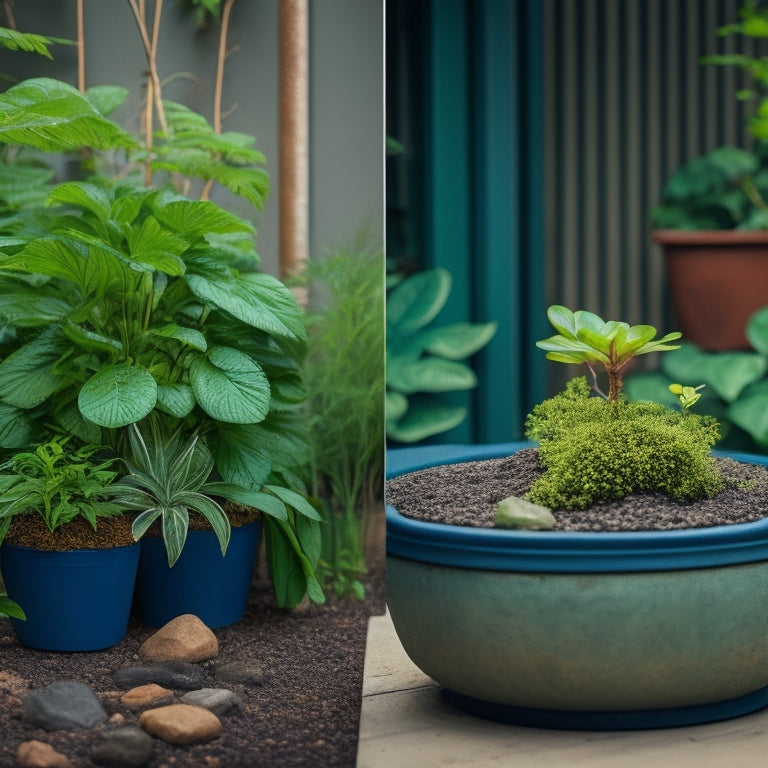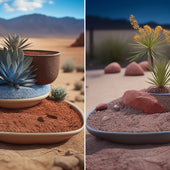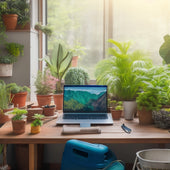
Drainage Solutions for Waterlogged Planters Made Easy
Share
You can breathe new life into your waterlogged planter by implementing simple yet effective drainage solutions. Start by evaluating your planter for signs of waterlogging, and clear any clogs in the drainage holes. Then, create new holes or elevate your planter to encourage downward water flow. Consider adding aggregate to your soil mix to enhance drainage speed and reduce the risk of waterlogging. For a more thorough solution, install a French drain system around your planter. With these steps, you'll be well on your way to a thriving, water-free planter - and there's even more to explore to guarantee your plants receive the perfect balance of water and air.
Key Takeaways
• Inspect and clear clogged drainage holes to restore proper water flow and prevent moisture retention in planters.
• Drill or chisel drainage holes in cinder block planters to improve water flow and reduce waterlogging risk.
• Elevate planters to create a slope, encouraging downward water flow and promoting healthy root growth.
• Add aggregate like perlite or vermiculite to soil mix to enhance drainage speed and reduce waterlogging risk.
• Install a French drain system around planters to direct water away and prevent water accumulation.
Assessing Waterlogged Cinder Block Planters
When you suspect your cinder block planter is waterlogged, inspect the drainage holes to verify they're not clogged with debris, as this is often the primary culprit behind water accumulation.
Check for any visible blockages, such as dirt, leaves, or roots, that might be preventing water from escaping. Clearing these obstructions can help restore proper drainage and prevent moisture retention, which can lead to root rot and poor plant growth.
Next, inspect the planter's interior for signs of waterlogging, such as water pooling at the bottom or yellowing leaves.
If you notice any of these symptoms, it's likely that the soil is retaining too much moisture, compromising root health.
Verify the soil's moisture levels by inserting your finger into the soil up to the knuckle. If the soil feels soggy or waterlogged, it's time to take action to improve drainage.
Creating Drainage Holes in Cinder
To guarantee effective drainage in your cinder block planter, you'll need to create holes that allow water to escape. This involves drilling or chiseling into the cinder material to create pathways for excess moisture to exit. This process is essential in cinder block construction, as it guarantees proper planter water management and prevents waterlogged soil.
When drilling, use a masonry bit to create holes that are about 1-2 inches in diameter and 1-2 inches deep. Space them evenly, about 6-8 inches apart, to allow for efficient water flow. If you prefer chiseling, use a hammer and chisel to create smaller holes, about 1/4 inch in diameter. Be sure to wear protective gear, including gloves and safety glasses, to avoid injury.
As you create the drainage holes, visualize the water flowing through the planter and out of the holes, carrying excess moisture with it. This mental image will help you strategically place the holes for best drainage.
Raising Cinder Block Planters Elevated
By elevating your cinder block planter, you'll create a slope that encourages water to flow downwards, further enhancing the drainage system you've established. This simple yet effective technique takes advantage of gravity, ensuring that excess water doesn't accumulate in your planter.
To achieve ideal planter elevation, place a layer of compacted gravel or sand beneath the cinder blocks. This base layer provides a stable foundation, allowing you to adjust the height of your planter as needed.
Cinder block benefits include their natural porosity, which allows for airflow and moisture evaporation. By elevating your planter, you're amplifying these benefits, creating an environment that promotes healthy plant growth.
Visualize the water flowing effortlessly down the slope, away from your plants' roots, and into a nearby drainage system. With your elevated cinder block planter, you'll enjoy improved drainage, reduced waterlogging, and a thriving garden.
Adding Aggregate for Better Drainage
You can further enhance your planter's drainage capabilities by incorporating aggregate, such as perlite, vermiculite, or coarse sand, into the soil mix. This creates air pockets and increases the rate at which excess water flows through. This is especially important when working with dense soil compositions that can impede water flow. By adding aggregate, you're fundamentally creating a more porous soil structure that allows water to drain freely.
Here are some benefits of using aggregate in your planter's soil mix:
-
Improved drainage: Aggregate materials increase the speed at which water drains through the soil, reducing the risk of waterlogging.
-
Aerated soil: Air pockets created by the aggregate allow roots to breathe and absorb oxygen more efficiently.
-
Reduced soil compaction: Aggregate helps to break up dense soil, making it easier for roots to grow and spread.
- Better root growth: With improved drainage and aeration, roots can grow stronger and healthier, leading to more robust plant growth.
Installing a French Drain System
One highly effective way to guarantee your planter drains excess water efficiently is to install a French drain system, which involves creating a subtle, sloping trench that directs water away from the roots. This system is particularly useful for planters with poor drainage or those situated in low-lying areas. By installing a French drain, you can enjoy several benefits, including reduced waterlogging, improved soil aeration, and enhanced plant growth.
Here's a breakdown of the French drain installation process and its benefits:
| Step | Description |
|---|---|
| 1 | Dig a trench around the planter, sloping it slightly to direct water away |
| 2 | Line the trench with a waterproof membrane to prevent soil erosion |
| 3 | Fill the trench with aggregate (e.g., gravel or crushed stone) |
| 4 | Install a perforated pipe to direct water flow |
| 5 | Cover the pipe with more aggregate and backfill the trench |
Frequently Asked Questions
Can I Use Regular Potting Soil in Waterlogged Planters?
You're wondering if you can use regular potting soil in waterlogged planters. The short answer is no.
Regular potting soil retains too much moisture, exacerbating waterlogging. Instead, consider potting soil alternatives that balance moisture retention with drainage.
Look for mixes with perlite, vermiculite, or sand that allow excess water to escape. By making this switch, you'll create a healthier environment for your plants to thrive.
How Often Should I Water Plants in Planters With Drainage Holes?
When deciding how often to water plants in planters with drainage holes, you'll want to take into account the watering frequency and moisture retention of the soil.
Check the soil daily, and water only when the top 1-2 inches feel dry to the touch. Avoid overwatering, as this can lead to root rot.
For plants with high moisture retention, like succulents, you may only need to water every 7-10 days.
For plants with low moisture retention, like ferns, you may need to water every 3-5 days.
Will Adding Charcoal Help With Drainage and Prevent Waterlogging?
You're wondering if adding charcoal to your planter will help with drainage and prevent waterlogging? Let's dig in!
Charcoal benefits extend beyond filtering impurities; it can also improve drainage by increasing the soil's water-absorbing capacity.
As water flows through, charcoal's porous structure helps to redirect excess moisture, reducing the likelihood of waterlogging.
Can I Drill Drainage Holes in Concrete or Brick Planters Too?
When working with concrete or brick planters, you can indeed drill drainage holes to prevent waterlogging.
To do this effectively, you'll need to employ specific drilling techniques tailored to the planter material.
For concrete, use a masonry bit and gentle pressure to avoid cracking.
With brick, opt for a carbide-tipped bit and slow, controlled movements to prevent shattering.
Do Self-Watering Planters Eliminate the Need for Drainage Solutions?
Did you know that over 90% of plant deaths are due to overwatering?
When it comes to self-watering planters, you're probably wondering if they eliminate the need for drainage solutions.
While self-watering planters do provide benefits like reduced watering frequency, they still require planter maintenance to prevent waterlogged soil.
The self-watering feature doesn't replace drainage solutions entirely, as excess water can still accumulate.
You'll need to guarantee your planter has proper drainage holes to prevent waterlogged soil and root rot.
Conclusion
As you step back to admire your revamped planters, envision the water flowing freely, like a gentle brook, through the cleverly crafted drainage holes.
The cinder blocks, once waterlogged and lifeless, now thrive, thanks to your ingenuity.
The added aggregate and French drain system work in harmony, ensuring roots breathe easily.
Your plants flourish, and the once-dreary planters now radiate vibrancy, a demonstration of your mastery of drainage solutions.
Related Posts
-

5 Must-Knows for Buying Used Tools for Planters
When buying used tools for planters, you're investing in the reliability and performance of your operations, so it's ...
-

5 Must-Knows for Buying Used Tools for Planters
When buying used tools for planters, you're investing in the reliability and performance of your operations, so it's ...
-

5 Must-Knows for Buying Used Tools for Planters
When buying used tools for planters, you're investing in the reliability and performance of your operations, so it's ...
-

5 Must-Knows for Buying Used Tools for Planters
When buying used tools for planters, you're investing in the reliability and performance of your operations, so it's ...
-

5 Must-Knows for Buying Used Tools for Planters
When buying used tools for planters, you're investing in the reliability and performance of your operations, so it's ...
-

5 Must-Knows for Buying Used Tools for Planters
When buying used tools for planters, you're investing in the reliability and performance of your operations, so it's ...
-

5 Must-Knows for Buying Used Tools for Planters
When buying used tools for planters, you're investing in the reliability and performance of your operations, so it's ...
-

5 Must-Knows for Buying Used Tools for Planters
When buying used tools for planters, you're investing in the reliability and performance of your operations, so it's ...
-

5 Must-Knows for Buying Used Tools for Planters
When buying used tools for planters, you're investing in the reliability and performance of your operations, so it's ...
-

5 Must-Knows for Buying Used Tools for Planters
When buying used tools for planters, you're investing in the reliability and performance of your operations, so it's ...
-

5 Must-Knows for Buying Used Tools for Planters
When buying used tools for planters, you're investing in the reliability and performance of your operations, so it's ...
-

5 Must-Knows for Buying Used Tools for Planters
When buying used tools for planters, you're investing in the reliability and performance of your operations, so it's ...
-

5 Must-Knows for Buying Used Tools for Planters
When buying used tools for planters, you're investing in the reliability and performance of your operations, so it's ...
-

5 Must-Knows for Buying Used Tools for Planters
When buying used tools for planters, you're investing in the reliability and performance of your operations, so it's ...
-

5 Must-Knows for Buying Used Tools for Planters
When buying used tools for planters, you're investing in the reliability and performance of your operations, so it's ...
-

5 Must-Knows for Buying Used Tools for Planters
When buying used tools for planters, you're investing in the reliability and performance of your operations, so it's ...
-

5 Must-Knows for Buying Used Tools for Planters
When buying used tools for planters, you're investing in the reliability and performance of your operations, so it's ...
-

5 Must-Knows for Buying Used Tools for Planters
When buying used tools for planters, you're investing in the reliability and performance of your operations, so it's ...
-

5 Must-Knows for Buying Used Tools for Planters
When buying used tools for planters, you're investing in the reliability and performance of your operations, so it's ...
-

5 Must-Knows for Buying Used Tools for Planters
When buying used tools for planters, you're investing in the reliability and performance of your operations, so it's ...
-

Preventing Soil Settlement in DIY Planters
To prevent soil settlement in your DIY planters, you'll want to focus on selecting a well-balanced soil mix with good...
-

Preventing Soil Settlement in DIY Planters
To prevent soil settlement in your DIY planters, you'll want to focus on selecting a well-balanced soil mix with good...
-

Preventing Soil Settlement in DIY Planters
To prevent soil settlement in your DIY planters, you'll want to focus on selecting a well-balanced soil mix with good...
-

Preventing Soil Settlement in DIY Planters
To prevent soil settlement in your DIY planters, you'll want to focus on selecting a well-balanced soil mix with good...
-

Preventing Soil Settlement in DIY Planters
To prevent soil settlement in your DIY planters, you'll want to focus on selecting a well-balanced soil mix with good...
-

Preventing Soil Settlement in DIY Planters
To prevent soil settlement in your DIY planters, you'll want to focus on selecting a well-balanced soil mix with good...
-

Preventing Soil Settlement in DIY Planters
To prevent soil settlement in your DIY planters, you'll want to focus on selecting a well-balanced soil mix with good...
-

Preventing Soil Settlement in DIY Planters
To prevent soil settlement in your DIY planters, you'll want to focus on selecting a well-balanced soil mix with good...
-

Preventing Soil Settlement in DIY Planters
To prevent soil settlement in your DIY planters, you'll want to focus on selecting a well-balanced soil mix with good...
-

Preventing Soil Settlement in DIY Planters
To prevent soil settlement in your DIY planters, you'll want to focus on selecting a well-balanced soil mix with good...
-

Preventing Soil Settlement in DIY Planters
To prevent soil settlement in your DIY planters, you'll want to focus on selecting a well-balanced soil mix with good...
-

Preventing Soil Settlement in DIY Planters
To prevent soil settlement in your DIY planters, you'll want to focus on selecting a well-balanced soil mix with good...
-

Preventing Soil Settlement in DIY Planters
To prevent soil settlement in your DIY planters, you'll want to focus on selecting a well-balanced soil mix with good...
-

Preventing Soil Settlement in DIY Planters
To prevent soil settlement in your DIY planters, you'll want to focus on selecting a well-balanced soil mix with good...
-

Preventing Soil Settlement in DIY Planters
To prevent soil settlement in your DIY planters, you'll want to focus on selecting a well-balanced soil mix with good...
-

Preventing Soil Settlement in DIY Planters
To prevent soil settlement in your DIY planters, you'll want to focus on selecting a well-balanced soil mix with good...
-

Preventing Soil Settlement in DIY Planters
To prevent soil settlement in your DIY planters, you'll want to focus on selecting a well-balanced soil mix with good...
-

Preventing Soil Settlement in DIY Planters
To prevent soil settlement in your DIY planters, you'll want to focus on selecting a well-balanced soil mix with good...
-

Preventing Soil Settlement in DIY Planters
To prevent soil settlement in your DIY planters, you'll want to focus on selecting a well-balanced soil mix with good...
-

Preventing Soil Settlement in DIY Planters
To prevent soil settlement in your DIY planters, you'll want to focus on selecting a well-balanced soil mix with good...
-

Preventing Soil Settlement in DIY Planters
To prevent soil settlement in your DIY planters, you'll want to focus on selecting a well-balanced soil mix with good...
-

Preventing Soil Settlement in DIY Planters
To prevent soil settlement in your DIY planters, you'll want to focus on selecting a well-balanced soil mix with good...
-

Preventing Soil Settlement in DIY Planters
To prevent soil settlement in your DIY planters, you'll want to focus on selecting a well-balanced soil mix with good...
-

Preventing Soil Settlement in DIY Planters
To prevent soil settlement in your DIY planters, you'll want to focus on selecting a well-balanced soil mix with good...
-

Must-Have Tools for Building Block Planters Online
When building block planters online, you'll need essential tools to guarantee a sturdy and visually appealing structu...
-

Must-Have Tools for Building Block Planters Online
When building block planters online, you'll need essential tools to guarantee a sturdy and visually appealing structu...
-

Must-Have Tools for Building Block Planters Online
When building block planters online, you'll need essential tools to guarantee a sturdy and visually appealing structu...
-

Must-Have Tools for Building Block Planters Online
When building block planters online, you'll need essential tools to guarantee a sturdy and visually appealing structu...
-

Must-Have Tools for Building Block Planters Online
When building block planters online, you'll need essential tools to guarantee a sturdy and visually appealing structu...
-

Must-Have Tools for Building Block Planters Online
When building block planters online, you'll need essential tools to guarantee a sturdy and visually appealing structu...
-

Must-Have Tools for Building Block Planters Online
When building block planters online, you'll need essential tools to guarantee a sturdy and visually appealing structu...
-

Must-Have Tools for Building Block Planters Online
When building block planters online, you'll need essential tools to guarantee a sturdy and visually appealing structu...
-

Must-Have Tools for Building Block Planters Online
When building block planters online, you'll need essential tools to guarantee a sturdy and visually appealing structu...
-

Must-Have Tools for Building Block Planters Online
When building block planters online, you'll need essential tools to guarantee a sturdy and visually appealing structu...
-

Must-Have Tools for Building Block Planters Online
When building block planters online, you'll need essential tools to guarantee a sturdy and visually appealing structu...
-

Must-Have Tools for Building Block Planters Online
When building block planters online, you'll need essential tools to guarantee a sturdy and visually appealing structu...
-

Must-Have Tools for Building Block Planters Online
When building block planters online, you'll need essential tools to guarantee a sturdy and visually appealing structu...
-

Must-Have Tools for Building Block Planters Online
When building block planters online, you'll need essential tools to guarantee a sturdy and visually appealing structu...
-

Must-Have Tools for Building Block Planters Online
When building block planters online, you'll need essential tools to guarantee a sturdy and visually appealing structu...
-

Must-Have Tools for Building Block Planters Online
When building block planters online, you'll need essential tools to guarantee a sturdy and visually appealing structu...
-

Must-Have Tools for Building Block Planters Online
When building block planters online, you'll need essential tools to guarantee a sturdy and visually appealing structu...
-

Must-Have Tools for Building Block Planters Online
When building block planters online, you'll need essential tools to guarantee a sturdy and visually appealing structu...
-

Must-Have Tools for Building Block Planters Online
When building block planters online, you'll need essential tools to guarantee a sturdy and visually appealing structu...
-

Must-Have Tools for Building Block Planters Online
When building block planters online, you'll need essential tools to guarantee a sturdy and visually appealing structu...
-

Must-Have Tools for Building Block Planters Online
When building block planters online, you'll need essential tools to guarantee a sturdy and visually appealing structu...
-

Must-Have Tools for Building Block Planters Online
When building block planters online, you'll need essential tools to guarantee a sturdy and visually appealing structu...
-

Must-Have Tools for Building Block Planters Online
When building block planters online, you'll need essential tools to guarantee a sturdy and visually appealing structu...


